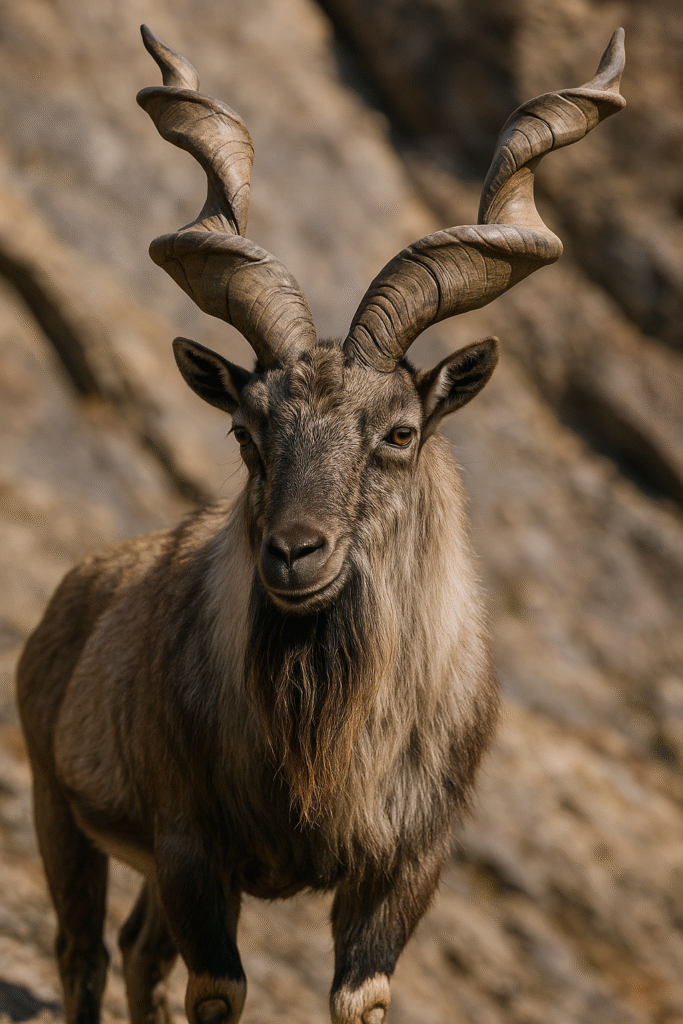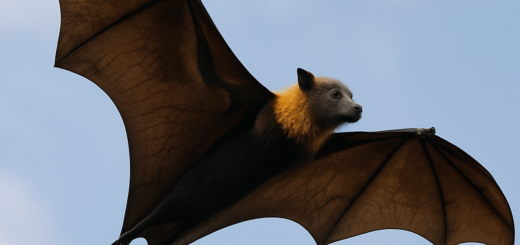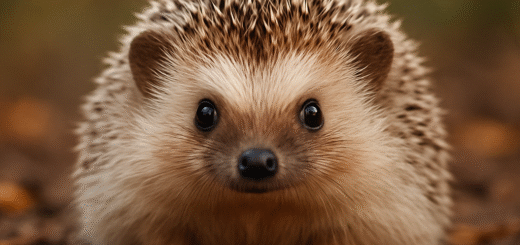Markhor: The Majestic Mountain Goat of Central Asia
The Markhor (scientific name Capra falconeri) is a species of wild goat native to the mountainous regions of Central Asia, particularly in countries like Pakistan, Afghanistan, Tajikistan, and Uzbekistan. With its striking appearance and remarkable adaptability, the Markhor stands as one of the most iconic and endangered species in the region. In this article, we will explore the beauty, habits, and conservation efforts surrounding this unique mountain goat.

Physical Characteristics of the Markhor
The Markhor is instantly recognizable due to its twisted, corkscrew-shaped horns, which can grow up to 1.5 meters (5 feet) long in males. These horns are not only a unique feature of the species but also serve as a tool in battles among males during the breeding season. The coat of the Markhor is typically brown or grayish, with lighter underparts, and thick fur that provides insulation against the cold climates of the high-altitude areas they inhabit.
Adult males, or billies, are significantly larger than females, or nannies, reaching weights of up to 100 kilograms (220 pounds) and heights of 90-115 cm (35-45 inches) at the shoulder. In comparison, females weigh between 30 and 50 kilograms (66-110 pounds) and have much smaller, less twisted horns. Markhors are agile climbers, with hooves specially adapted to help them navigate rocky terrains and steep cliffs.
Habitat and Distribution
Markhors are typically found at high elevations ranging from 1,200 meters (3,900 feet) to 3,600 meters (11,800 feet) above sea level. These goats thrive in rugged, rocky mountainous landscapes where the terrain is difficult for predators to navigate. Their habitat is usually covered in forests, with a mix of oak, pine, and juniper trees. In winter, they descend to lower altitudes but still remain within the mountainous areas.
The Markhor’s geographic range is scattered across several regions, with distinct populations found in Pakistan’s Karakoram Mountains, Hindu Kush, and Tian Shan mountain ranges. In fact, Pakistan is home to the largest population of Markhors, with over 2,000 individuals living in the wild. However, habitat loss, poaching, and human-wildlife conflict have caused the population to dwindle in many areas.
Diet and Behavior
Markhors are herbivores, primarily grazing on grasses, shrubs, and the leaves of trees. In colder seasons, they may also feed on lichens and bark to supplement their diet. These goats are known for their seasonal migrations, moving between higher and lower elevations based on food availability and weather conditions.
Socially, Markhors are most often seen in small groups. Females and their young form herds of up to 20 individuals, while males tend to be solitary, except during the mating season. The breeding season typically occurs in winter, when male Markhors compete for access to females. The males’ dramatic horn displays and vocalizations play a crucial role in securing mates. After mating, females give birth to a single kid, usually in spring, which stays with the mother for up to a year.
Conservation Status of the Markhor
The Markhor is listed as Endangered on the International Union for Conservation of Nature’s (IUCN) Red List. The primary threats to the species include habitat degradation, illegal hunting, and competition with livestock. In some areas, Markhors are hunted for their horns, meat, and skins. Habitat destruction, caused by logging, mining, and the encroachment of agriculture, further exacerbates the decline of the species.
However, there has been significant progress in recent years to conserve the Markhor. The government of Pakistan and local conservation organizations have implemented protected areas where the species can live without fear of poaching. One of the most notable success stories is the establishment of game reserves in northern Pakistan, where Markhor populations have started to recover due to strict anti-poaching laws and community-based wildlife management programs.
In addition to government efforts, conservation programs have been working to raise awareness among local communities, educating them about the importance of preserving the Markhor. By involving local populations in conservation efforts, such as eco-tourism and sustainable grazing practices, these initiatives help ensure the long-term survival of the species.
The Markhor and its Cultural Significance
The Markhor holds a special place in local culture and folklore. In many areas, it is revered as a symbol of strength, endurance, and resilience. Its graceful yet powerful appearance has made it a prominent figure in Central Asian mythology. The Markhor is even featured in the national emblems of both Pakistan and Afghanistan, symbolizing the natural heritage of the region.
For the people living in the highlands of Pakistan, the Markhor is a source of both pride and sustenance. Its meat is traditionally consumed, and its horns are used in handicrafts. However, in recent years, the importance of conserving the Markhor as part of the region’s natural heritage has gained more recognition, leading to increased efforts to protect this remarkable creature.
How You Can Help
If you’re passionate about wildlife conservation and want to support the protection of the Markhor, there are several ways you can contribute:
- Support organizations that work on the ground in Central Asia to protect wildlife and restore habitats.
- Adopt sustainable practices in your own life, such as reducing your carbon footprint and supporting eco-friendly products.
- Donate to conservation projects that focus on endangered species and habitat restoration.
Conclusion
The Markhor is one of the most fascinating and endangered animals in Central Asia. With its striking twisted horns, remarkable adaptability, and strong cultural significance, it remains a symbol of the rugged mountains it calls home. While its future still faces numerous challenges, ongoing conservation efforts provide hope for this majestic goat. By supporting these efforts, we can ensure that the Markhor continues to thrive in the wild for generations to come.








